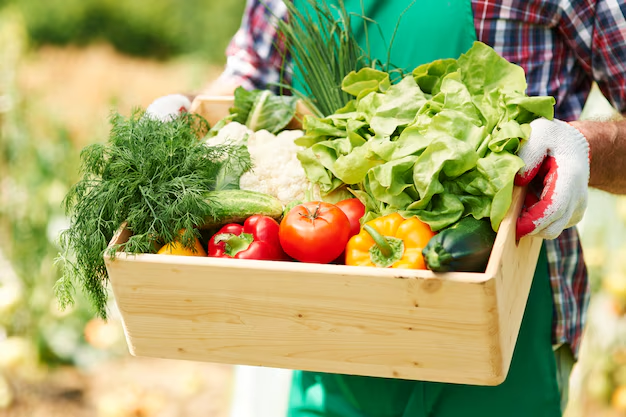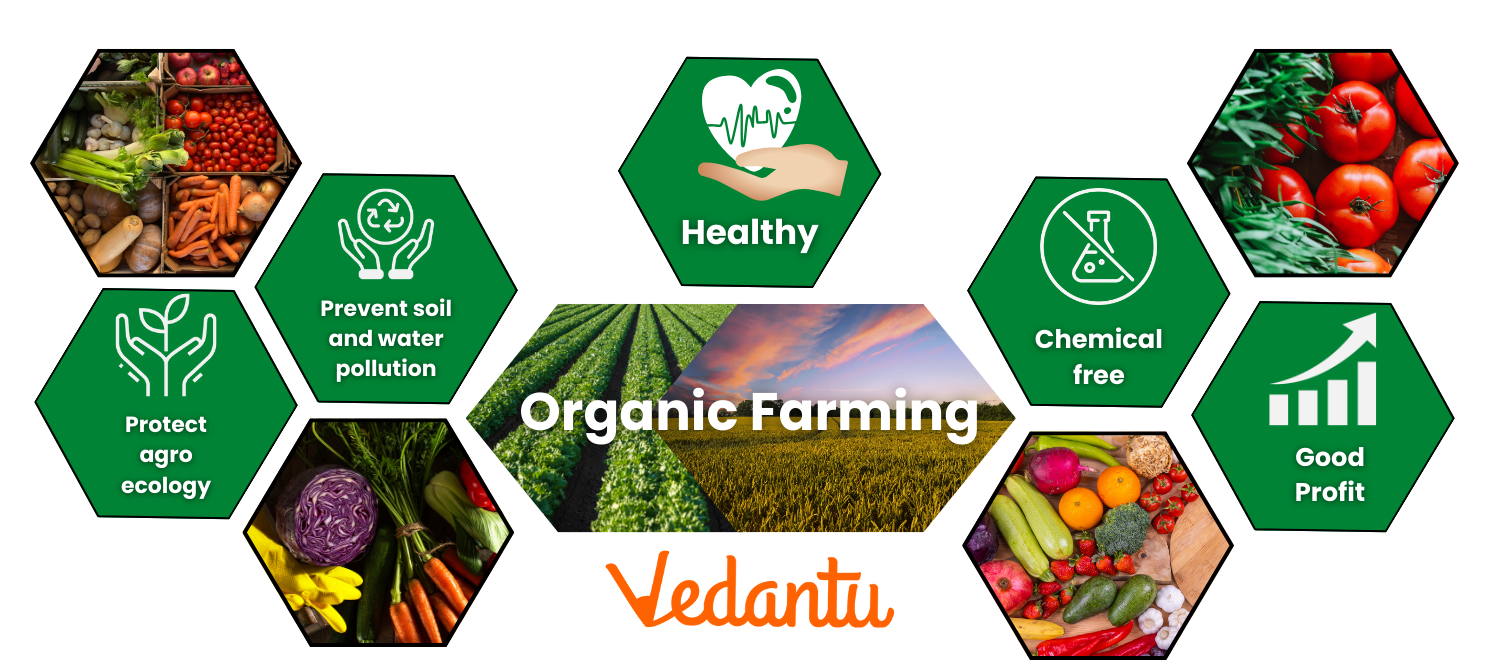




Learn Organic Farming: History, Importance, Types and Benefits
Organic farming is a way of growing crops and raising animals using natural methods. It avoids harmful chemicals like synthetic pesticides and fertilisers and does not use genetically modified organisms (GMOs). Instead, organic farming focuses on natural processes like crop rotation, composting, and using beneficial insects to control pests. This helps keep the soil healthy, protect biodiversity, and produce food that is better for people and the environment.
The main goal of organic farming is to grow healthier food while also protecting the planet by reducing pollution and conserving natural resources. This article provides a clear and simple explanation of organic farming. It highlights its practices, benefits, and why it is an essential step toward sustainable agriculture for a healthier future.

What is Organic Farming?
Organic farming is a method of agriculture that excludes the use of synthetic fertilisers, pesticides, genetically modified organisms (GMOs), and growth hormones. Instead, it emphasises:
Natural Fertilisers: Compost, manure, and green manure.
Pest Management: Biological controls like natural predators and organic pesticides.
Sustainable Practices: Crop rotation, intercropping, and polyculture to maintain soil fertility and reduce pest outbreaks.
In essence, organic farming works in harmony with nature, preserving ecological balance while producing healthier and safer food.
Importance of Organic Farming
Organic farming is a sustainable agricultural practice that relies on natural processes and avoids synthetic chemicals, such as pesticides and fertilisers. It emphasises soil health, biodiversity, and ecological balance while producing nutritious and chemical-free crops. The growing focus on environmental conservation and healthy living has made organic farming increasingly important.

Features of Organic Farming
Relies on organic fertilizers, such as compost, green manure, and biofertilizers.
Promotes soil microorganisms and nutrients for sustainable crop production.
Maintains biodiversity by integrating crops, animals, and beneficial insects.
Avoids synthetic pesticides and herbicides, ensuring safer food production.
Focuses on multiple cropping systems to prevent soil depletion and pest outbreaks.
Types of Organic Farming
Pure Organic Farming:
No synthetic inputs are used.
Fertilizers and pest control substances are entirely natural, such as compost, green manure, and animal waste.
Integrated Organic Farming:
Combines organic methods with limited synthetic inputs.
Ensures a balance between high yield and ecological safety.
How to Prepare an Organic Farm?
Soil Preparation: Test soil for nutrients and pH. Add compost, organic manure, and green manure to enrich fertility.
Crop Planning: Choose crops based on climate, soil type, and local market demand.
Irrigation Management: Implement water-saving techniques like drip irrigation or rainwater harvesting.
Weed Control: Use mulching, crop rotation, and manual weeding to manage weed growth.
Pest Management: Introduce natural predators, biological controls, and organic repellents.
Benefits of Organic Farming
Reduced dependence on expensive synthetic fertilizers and pesticides.
Higher returns from premium-priced organic products.
Organic crops are rich in nutrients and free from chemical residues, offering better health benefits.
Reduces carbon footprint by relying on renewable resources.
Mitigates water and soil pollution.
Provides employment opportunities due to the labour-intensive nature of organic farming.
Organic products command higher demand in international markets, boosting foreign exchange reserves.
Challenges in Organic Farming
Organic farming often produces fewer crops per hectare compared to conventional methods.
Transitioning from conventional to organic farming requires investment in infrastructure, training, and certification.
Organic fertilizers and pest control substances have shorter usability durations.
Farmers need in-depth understanding and expertise to implement organic farming successfully.
How Organic Farming Differs from Conventional Farming
Relevance of Organic Farming in India
India's diverse agro-climatic zones make it ideal for organic farming. Regions like Sikkim have already achieved 100% organic status, proving that this sustainable method can thrive. With rising global demand for organic produce, India has immense potential to become a leading exporter, providing both economic and environmental benefits.
Conclusion
Organic farming is not just an agricultural method—it’s a movement toward a healthier planet and society. By reducing dependence on harmful chemicals and focusing on sustainable practices, organic farming benefits farmers, consumers, and the environment. Embracing organic farming ensures a balanced ecosystem, superior-quality produce, and long-term agricultural productivity. Adopting organic practices is a step toward a greener, more sustainable future.
FAQs on Organic Farming: Detailed Explanation
1. What is organic farming?
Organic farming is a method of agriculture that uses natural processes and substances to grow crops and raise livestock without relying on synthetic chemicals or genetically modified organisms (GMOs).
2. What are the benefits of organic farming?
The benefits of organic farming include improved soil health, reduced environmental pollution, healthier food, conservation of biodiversity, and better sustainability of agricultural systems.
3. What are the types of organic farming?
The types of organic farming include pure organic farming, which avoids all synthetic inputs, and integrated organic farming, which combines organic methods with minimal synthetic practices.
4. What is the importance of organic farming?
Organic farming is important because it promotes sustainable agriculture, conserves natural resources, reduces pollution, and produces chemical-free, healthier food for consumers.
5. What are the disadvantages of organic farming?
The disadvantages of organic farming include lower initial yields, higher labor costs, limited shelf life of organic inputs, and the need for more knowledge and expertise.
6. What about organic farming is unique?
What makes organic farming unique is its reliance on natural methods like composting, crop rotation, and biological pest control, which maintain ecological balance and produce healthier food.
7. What are the principles of organic farming?
The principles of organic farming include health (promoting soil and human health), ecology (working with natural systems), fairness (considering social and environmental equity), and care (protecting the environment for future generations).
8. What are the objectives of organic farming?
The objectives of organic farming are to improve soil fertility, reduce environmental impact, produce safe and nutritious food, and promote biodiversity.
9. What is the history of organic farming?
The history of organic farming dates back to the early 20th century, when pioneers like Sir Albert Howard and J.I. Rodale emphasised the importance of natural farming methods to counteract the negative effects of industrial agriculture.




































